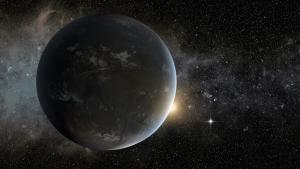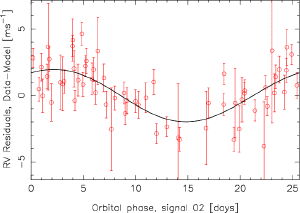Blog
False Positive
29 April 2014
 NASA Ames/JPL-Caltech
NASA Ames/JPL-CaltechLast year a paper in the Astrophysical Journal announced the discovery of two super-Earths orbiting a low metallicity Sun-like star known as HD41248.1 This was kind of a big deal, because it demonstrated that low metallicity stars could have rocky planets. Most of the known exoplanets are around higher metallicity stars. The two planets were discovered by observing the radial motion of the star (it motion toward or away from us) as measured by the Doppler shift of the starlight. Now a new paper in Astronomy and Astrophysics demonstrates that the planets likely don’t exist.2
 Jenkins, et al
Jenkins, et alSo how is it that a planet can be discovered one year and lost the next? It all has to do with the complexities of the observations. Exoplanets are not discovered by actually observing them directly. Of the hundreds of known exoplanets, only a few large ones have been directly imaged. The rest have been discovered by their effect on the star they orbit, either by passing in front of the star causing it to dim slightly (transit method) or by measuring the wobble of the star as it is gravitationally pulled by the planet (radial velocity measure).
Of these two main methods, the transit method tends to be more reliable, but it only works if the planet passes in front of the star from our vantage point. The radial velocity method can work regardless of the orientation of a planet’s orbit, but it has much more noise in the data. That’s because the wobble of a star due to a planet is quite small, and with all the noise in the data you can sometimes get a false positive.
To measure the radial motion of the star, we measure the Doppler shift of the light emitted from the star. This light comes from the photosphere of the star. As the star wobbles toward and away from us, so does the photosphere of course, so by measuring this Doppler shift we can measure the motion of the star. But photosphere can have motion independent of the motion of the star. Stellar activity such as starspots and flares can cause the photosphere to swell or shrink slightly, and that produces a Doppler shift as well. Distinguishing between these different motions is a difficult challenge.
The original paper found signals of two planets, one with a period of 25 days, and the other with a period of 18 days. Of these two signals, the 25 day period was the strongest. The result was based upon 62 radial velocity measurements from the HARPS spectragraph, which is public data. Since then, more observations were made. The new paper looked at 162 new measurements, and from these determined that the 25 day period correlates with the rotational period of the star. The 18 day period wasn’t clear in the new data. So it seems that what looked like planets is instead stellar activity.
Just to be clear, the false positives of the first paper shouldn’t be viewed as a failure. The results presented were well analyzed given the data at hand. What this new paper shows is that the stellar activity of HD41248 is more complex than originally supposed. This activity, combined with its differential rotation results in Doppler motion data that looks very similar to planetary influence. This is cutting edge work, and as we do it we’re learning about where we need to be careful in our analysis.
Sometimes science is about making mistakes so we can learn from them.
Jenkins, James S., et al. “Two super-earths orbiting the solar analog HD 41248 on the edge of a 7: 5 mean motion resonance.” The Astrophysical Journal 771.1 (2013): 41. ↩︎
Santos, N. C., et al. “The HARPS search for southern extra-solar planets-XXXV. The interesting case of HD 41248: stellar activity, no planets?.” Astronomy & Astrophysics 566 (2014): A35. ↩︎